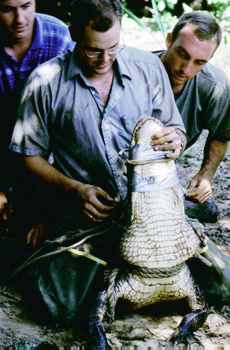- If You See an Alligator
- American Alligator Fact Sheet
 (PDF 293.1 KB)
(PDF 293.1 KB) - Alligators in Texas: Rules, Regulations and General Information
 (PDF 1.6 MB)
(PDF 1.6 MB) - Alligator Farming in Texas
 (0 B)
(0 B) - History of Alligators in Texas
- Managing Alligator Populations
- Alligators at Brazos Bend State Park
- American Alligator Research
Population Parameters of American Alligators in the Gus Engeling Wildlife Management Area
Wade A. Ryberg and Lee A. Fitzgerald, Texas A&M University, Dale F. Prochaska, Hayden Haucke, and James C. Cathey, Texas Parks and Wildlife Department
In spite of their popularity and importance, surprisingly little is known about populations of American alligators (Alligator mississippiensis) in Texas, particularly about populations located within inland, forested areas. We have noted interesting characteristics of alligators in inland areas that appear distinct from the more studied coastal populations. For example, while alligators seem to be present in creeks and impoundments within their inland range, we suspect they occur at relatively low population densities, and may persist as isolated family groups. Consequently, populations of alligators in these areas are probably structured very differently, both demographically and genetically, from coastal alligator populations. Clearly, these differences need to be quantified and understood for proper management of alligators in different parts of their range.

© Wade A. Rydberg
The Gus Engeling Wildlife Management Area (GEWMA) in eastern Texas provides an ideal location and unique opportunity to study alligators living within forested environments. This property, owned by Texas Parks and Wildlife Department (TPWD), is located in the Post Oak Savannah ecological region and encompasses approximately 10,956 acres (4,436 ha). There are 7 major spring-fed creeks within the boundaries of the property, all of which flow into Catfish Creek (a tributary of the Trinity River). Catfish Creek gained positive notoriety in 1983, when the creek and associated riparian corridor was designated a National Natural Landmark by the National Park Service. This honor was bestowed because the near pristine qualities of the creek represented a hardwood bottomland ecosystem that is rapidly vanishing throughout much of the United States. The purposes of our research are to identify factors influencing population structure and dynamics of the alligators, and to integrate information obtained into management strategies. To begin this work, searches were conducted for alligator nests. Once located, eggshell fragments and/or hatchlings were collected. Additional searches were conducted for larger alligators at night using spotlights. Alligators up to 4 feet (1.2 m) long were captured by hand or with nose poles. Additionally, box traps were used to capture alligators 4 feet (1.2 m) and larger. To date, we have captured and released 87 alligators. Once captured, measurements of total length, snout to vent, hind leg, and nare to eye were recorded. The sex of each animal was determined and recorded. Specific scutes from the tail were removed to permanently mark the animal; this tissue was reserved for future genetic work. Additionally, global positioning system (GPS) units were used to mark the location of each capture site.
Capture/recapture techniques will help determine the population size, demographic structure, and the distribution of alligators in Catfish Creek. Genetic structure of this population will be studied to determine metapopulation structure. We predict that family groups of alligators (i.e., female and her offspring) use individual tributaries or impoundments as breeding and/or nesting locations. By compiling this information, we will then be able to compare the data from this study to what is known about alligators in other environments. This basic study should be used as the starting point for future management decisions regarding inland alligator populations.
Funding was provided by Texas Parks and Wildlife Department, a Reagent's Fellowship, and Texas A&M University.